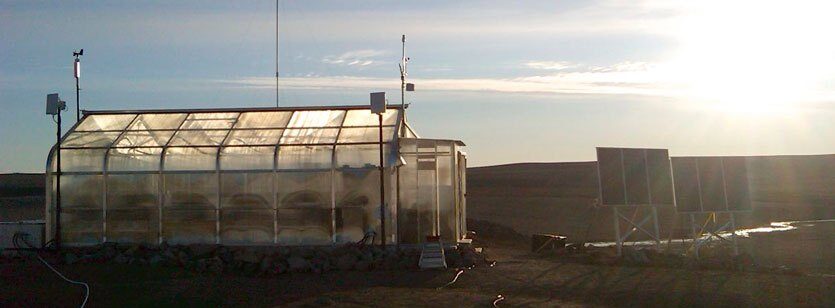Arthur Clarke Mars Greenhouse (ACMG)
Ground Control Research Tool

- Full Name: Arthur Clarke Mars Greenhouse
- Affiliation: NASA, CSA
- Country: Canada
- Focus Areas: Bioregenerative Life Support System
- Type: Ground Control
Summary
In the northernmost region of our planet, the arctic landscape appears cold and desolate year-round. Yet in the Canadian High Arctic, one tiny oasis glimmers alone in the snow. The Arthur Clarke Mars Greenhouse (ACMG) was built in this harsh environment to support research that will teach us about life in the universe and help pave the way for the human exploration of Mars.
It has six systems:
- Physical structure: steel frame with insulating polycarbonate sheets
- Plant growth system: automatic (hourly) drip-line irrigation, rockwool substrate, general-purpose fertilizer
- Environment control system: temperature is controlled, and other environmental parameters are logged for analysis but not controlled
- Power system: hybrid solar-wind system
- Communications system: local ethernet, embedded computer, and satellite connection
- Data acquisition and control system: controllers with non-volatile storage
Built in 2002, this greenhouse represents an international effort, with contributions from NASA, the Canadian Space Agency (CSA), and partners from industry and academia in Canada and the United States. For most of the year, this station runs by itself, with very few visitors. While this may seem counterintuitive for growing healthy plants, it provides us with a look at how we might grow plants in a remote location on another planet, with minimum human care. By using cameras and other tools to monitor plant growth and care for the plants, we’re testing technologies that will come in handy for growing plants on the Moon or Mars. The ACMG is not a high-fidelity simulation of a Mars greenhouse but supports numerous research projects with different goals related to Mars. Even though it only operates during the summer, it hosts several research projects including plant growth studies, environmental control studies, imaging systems trials, and greenhouse automation trials.
Resources
- Arthur Clarke Mars Greenhouse (ACMG): Frequently Asked Questions
- Greenhouses in extreme environments: The Arthur Clarke Mars Greenhouse design and operation overview
- A Green Thumb in Space: The Arthur Clarke Mars Greenhouse
- Greenhouse For A Red Planet
